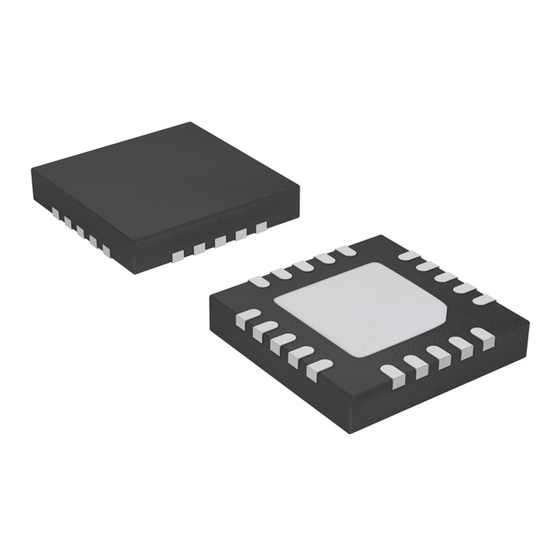Advertisement
Quick Links
C8051F33
X
1. Kit Contents
The C8051F33x Development Kit contains the following items:
• C8051F330 Target Board
• C8051Fxxx Development Kit Quick-Start Guide
• AC to DC Power Adapter
• USB Debug Adapter (USB to Debug Interface)
• USB Cable
• CD-ROM
2. Hardware Setup Using a USB Debug Adapter
The target board is connected to a PC running the Silicon Laboratories IDE via the USB Debug Adapter as shown
in Figure 1.
1. Connect the USB Debug Adapter to the DEBUG connector on the target board with the 10-pin ribbon cable.
2. Connect one end of the USB cable to the USB connector on the USB Debug Adapter.
3. Connect the other end of the USB cable to a USB Port on the PC.
4. Connect the ac/dc power adapter to power jack P1 on the target board.
Notes:
• Use the Reset button in the IDE to reset the target when connected using a USB Debug Adapter.
• Remove power from the target board and the USB Debug Adapter before connecting or disconnecting the
ribbon cable from the target board. Connecting or disconnecting the cable when the devices have power can
damage the device and/or the USB Debug Adapter.
PC
Rev. 0.7 2/14
D
EVELOPMENT
USB
Cable
Figure 1. Hardware Setup Using a USB Debug Adapter
Copyright © 2014 by Silicon Laboratories
K
U
'
IT
SER
S
AC/DC
Adapter
USB Debug Adapter
SILICON LABORATORIES
P1.6
Port 2
Port 1
C 8 0 5 1 F 3 3 x
G
U I D E
Target Board
PWR
MCU
Port 0
Port 3
Port 4
C8051F33x
Advertisement

Summary of Contents for Silicon Laboratories C8051F33 Series
- Page 1 • CD-ROM 2. Hardware Setup Using a USB Debug Adapter The target board is connected to a PC running the Silicon Laboratories IDE via the USB Debug Adapter as shown in Figure 1. 1. Connect the USB Debug Adapter to the DEBUG connector on the target board with the 10-pin ribbon cable.
-
Page 2: Software Setup
C8051F33x 3. Software Setup Simplicity Studio greatly reduces development time and complexity with Silicon Labs EFM32 and 8051 MCU products by providing a high-powered IDE, tools for hardware configuration, and links to helpful resources, all in one place. Once Simplicity Studio is installed, the application itself can be used to install additional software and documentation components to aid in the development and evaluation process. - Page 3 C8051F33x 3.1. Running Blinky Each project has its own source files, target configuration, SDK configuration, and build configurations such as the Debug and Release build configurations. The IDE can be used to manage multiple projects in a collection called a workspace.
- Page 4 C8051F33x 3.3. Legacy 8-bit IDE Note: Using the Simplicity Studio tools with the C8051F330 Development Kit is recommended. See section 3. "Software Setup‚" on page 2 for more information. Download the 8-bit software from the website (www.silabs.com/8bit-software) or use the provided installer on the CD-ROM to install the software tools for the C8051F33x devices.
- Page 5 C8051F33x information. 7. Once the form is complete, click the Submit button. An email will be sent to the provided email address with the license activation code. 8. Copy the License ID Code (LIC) from the email. 9. Paste the LIC into the New License ID Code (LIC) text box at the bottom of the License Management window in µVision4.
-
Page 6: Target Board
C8051F33x 4. Target Board The C8051F33x Development Kit includes a target board with a C8051F330 device pre-installed for evaluation and preliminary software development. Numerous input/output (I/O) connections are provided to facilitate prototyping using the target board. Refer to Figure 4 for the locations of the various I/O connectors. Power connector (accepts input from 7 to 15 VDC unregulated power adapter) 22-pin Expansion I/O connector Port I/O Configuration Jumper Block... - Page 7 C8051F33x 4.1. System Clock Sources The C8051F330 device installed on the target board features a calibrated programmable internal oscillator which is enabled as the system clock source on reset. After reset, the internal oscillator operates at a frequency of 3.0625 MHz (±2%) by default but may be configured by software to operate at other frequencies. Therefore, in many applications an external oscillator is not required.
- Page 8 C8051F33x 4.3. Expansion I/O Connector (J1) The 22-pin Expansion I/O connector J1 provides access to all signal pins of the C8051F330 device. Pins for +3 V, digital ground and the output of an on-board low-pass filter are also available. A small through-hole prototyping area is also provided.
- Page 9 C8051F33x 4.5. Serial Interface (J5) A RS232 transceiver circuit and DB-9 (J5) connector are provided on the target board to facilitate serial connections to UART0 of the C8051F330. The TX, RX, RTS and CTS signals of UART0 may be connected to the DB-9 connector and transceiver by installing shorting blocks on header J3.
- Page 10 C8051F33x 5. Schematic Rev. 0.7...
- Page 11 C8051F33x OCUMENT HANGE Revision 0.4 to Revision 0.5 Section 1, added USB Debug Adapter and USB Cable. Section 2, changed name from "Hardware Setup" to "Hardware Setup using an EC2 Serial Adapter". Section 2, added 2 Notes bullets. ...
- Page 12 The products must not be used within any Life Support System without the specific written consent of Silicon Laboratories. A "Life Support System" is any product or system intended to support or sustain life and/or health, which, if it fails, can be reasonably expected to result in significant personal injury or death.


Need help?
Do you have a question about the C8051F33 Series and is the answer not in the manual?
Questions and answers